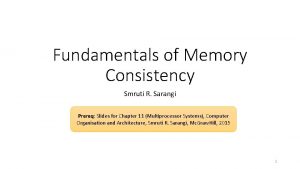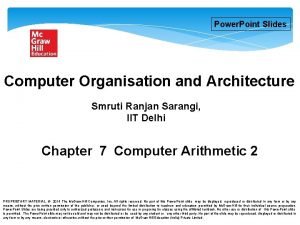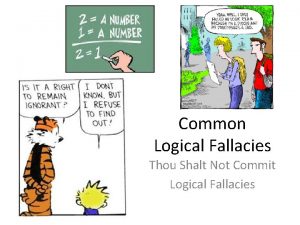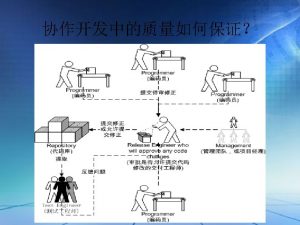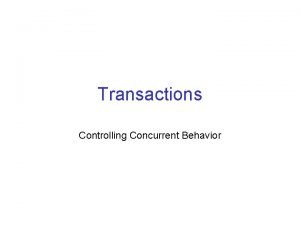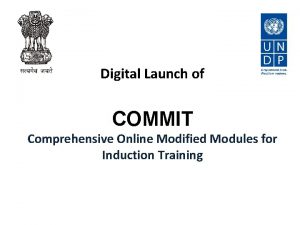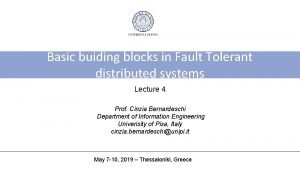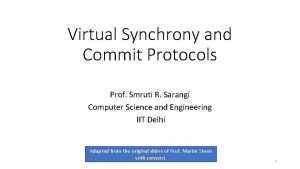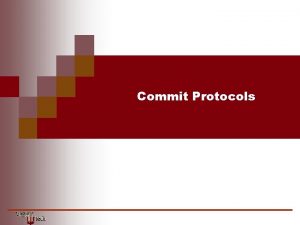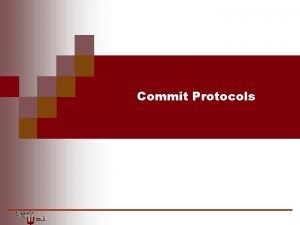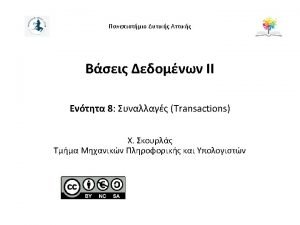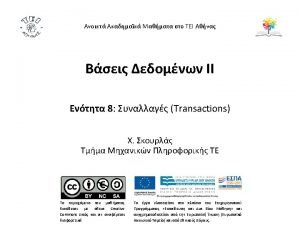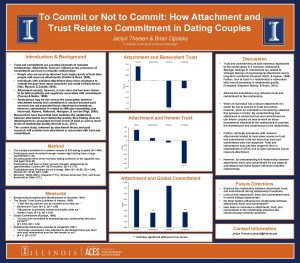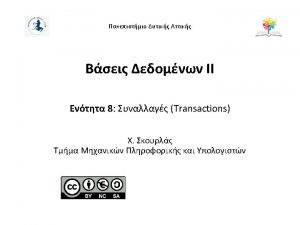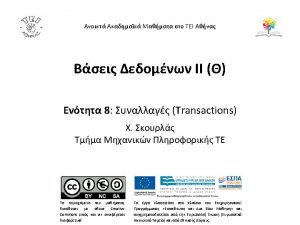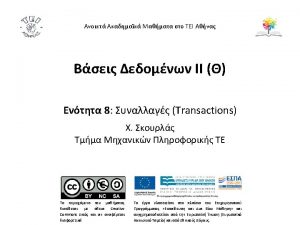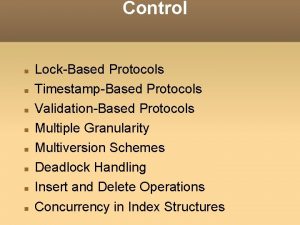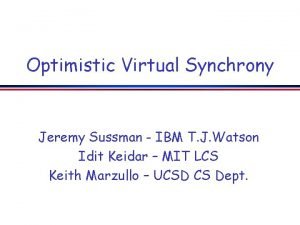Virtual Synchrony and Commit Protocols Prof Smruti R












![Stability and Flushing of Messages [Details] • A message is stable if it has Stability and Flushing of Messages [Details] • A message is stable if it has](https://slidetodoc.com/presentation_image_h/20b04d2b1bf7ebe8dce4d4b07b7fbb2a/image-13.jpg)










- Slides: 23

Virtual Synchrony and Commit Protocols Prof. Smruti R. Sarangi Computer Science and Engineering IIT Delhi Adapted from the original slides of Prof. Martin Steen with consent. 1

Virtual Synchrony 2

One-to-one Communication: Unicasting Client Server • Client-server • Messages can get lost. • There is a need to resend messages. • Two commonly used semantics • At-least-once semantics: The operation will be carried out by the server at least once. • At-most-once semantics: The operation will be carried out at most once. 3

Notion of Process Groups: Multicasting • Processes can exhibit all kinds of failures • Fail-silent: Just fails without any intimation. • Fail-stop: The failure can be detected. • Fail-safe: The failure is benign. • Create a group of processes to service the client’s request • Replicate the state across processes • Give the same user input to all the processes, collate the outputs, and decide the result based on voting • Failure tolerance • To tolerate k fail-stop failures, we need k+1 processes. • If processes produce arbitrary outputs, we need 2 k+1 processes (use voting) • If the process sending the input is malicious, we need 3 k+1 processes (Byzantine) 4

Reliable Multicasting • 5

Implementation in a LAN Sender Receiver ACK • • The sender sends a message to a set of receivers One of them sends an acknowledgement (ACK) on a shared channel The rest snoop the message If any receiver hasn’t gotten the original message, it requests for a retransmission 6

Virtually Synchronous Multicast • 7

Virtually Synchronous Multicast – View Changes • 8

Example of Virtual Synchrony P 1 P 2 P 3 P 4 G = {P 1, P 2, P 3, P 4} G = {P 1, P 3, P 4} G = {P 1, P 2, P 3, P 4} 9

Few more assumptions • Virtual synchrony is independent of the order of message delivery. 10

Implementation • 11

Implementation - II • Find the minimum in each column P 1 2 3 1 3 P 2 P 3 2 3 1 4 1 1 1 5 P 4 2 2 1 5 min 1 1 1 4 12
![Stability and Flushing of Messages Details A message is stable if it has Stability and Flushing of Messages [Details] • A message is stable if it has](https://slidetodoc.com/presentation_image_h/20b04d2b1bf7ebe8dce4d4b07b7fbb2a/image-13.jpg)
Stability and Flushing of Messages [Details] • A message is stable if it has been received by all the processes in the view (refer to the min. vector) • The message can be delivered to the process’s next layer • To remove a process a failure-detecting process needs to multicast a flush message to all the processes in the view. • All the processes stop sending new messages. • Processes send their rcvd arrays to other processes. • They also elect a leader (coordinator). Once a process finds that its messages have all been received, and it has received all the messages it sends a flush_ok message to the coordinator. Otherwise, after a timeout it sends its list of unstable messages. • If the coordinator does not get all the flush_ok messages in a given interval, it collects all the unstable messages, and multicasts them again. • After getting acknowledgements, it sends a view_change message. 13

Commit Protocols 14

Commit Protocols Either all of them commit or abort. Bank Agreement Credit card machine Data center Airline User 15

2 -Phase Commit • The nodes elect a coordinator • Phase 1 a: Coordinator sends a Vote-request message to all participants. • Phase 1 b: A participant returns either Vote-commit or Vote-abort • Phase 2 a: Coordinator collects all the votes. If all are Vote-commit it sends a Global-commit message, otherwise it sends a Global-abort message to all. • Phase 2 b: Each participant waits for the messages from Phase 2 a. It acts accordingly. 16

2 -Phase Commit Vote-Request Vote-Abort INIT Vote-Request Vote-Commit Vote Request READY WAIT Vote-Abort Global-abort Vote-Commit Global-commit ABORT COMMIT Coordinator INIT Global-abort ACK Global-commit ACK ABORT COMMIT Participant 17

Analysis of 2 -Phase Commit • Let’s say a participant fails, recovers and then restores its old state. • INIT state: No problem. It just aborts. • READY state: It needs to know the global decision (commit or abort) after it recovers. Ask the coordinator or other participants. • This is very problematic. • The coordinator might have failed. Other processes might have committed or aborted. They might have erased all the history of the transaction. • We will never know what decision the coordinator took. • ABORT state: Complete the abort process. • COMMIT state: Complete the commit process. 18

3 -Phase Commit The nodes elect a coordinator Phase 1 a: Coordinator sends a Vote-request message to all participants. Phase 1 b: A participant returns either Vote-commit or Vote-abort Phase 2 a: Coordinator collects all the votes. If all are Vote-commit it sends a Prepare-commit message, otherwise it sends a Global-abort message to all. • Phase 2 b: Each participant waits for the messages from Phase 2 a. If it gets a Prepare-commit message, it proceeds to send a Ready-commit message, else it aborts. • Phase 3 a: After the coordinator gets all the Ready-commit messages it sends a Global-commit message to all the participants. • Phase 3 b: The participants wait for the Global-commit message. • • 19

3 -Phase Commit Vote-Request Vote-Abort INIT Vote-Request Vote-Commit Vote Request READY WAIT Vote-Abort Global-abort ABORT INIT Vote-Commit Prepare-Commit PRECOMMIT Ready-Commit Global-commit Global-abort ACK Prepare-Commit Ready-Commit ABORT PRECOMMIT Global-commit ACK COMMIT Coordinator COMMIT Participant 20

Analysis • Consider the READY and PRECOMMIT states. • If a participant fails in the • READY state: It can ask the coordinator. If the coordinator has failed, then we can elect a new coordinator. If any process has gotten a PRECOMMIT message, then they proceed towards a global commit. Else all processes abort. • PRECOMMIT state: Elect a new coordinator that will send a Global-commit message. • Coordinator fails in the • WAIT state: Participants time out in the READY state • PRECOMMIT state: Participants time out in the PRECOMMIT state 21

References 1. Tanenbaum, Andrew S. , and Maarten Van Steen. Distributed systems: principles and paradigms. Prentice-Hall, 2007. [Thanks to Prof. Martin Steen for allowing us to adapt his original slides. ] https: //www. distributed-systems. net/index. php/books/ds 2/ 22

Thank you 23
 Smruti r. sarangi
Smruti r. sarangi Smruti sarangi
Smruti sarangi Smruti ranjan sarangi
Smruti ranjan sarangi Synchronic and diachronic linguistics
Synchronic and diachronic linguistics Cincom synchrony
Cincom synchrony Videotron
Videotron Busceral
Busceral Atomic commit protocol in distributed system
Atomic commit protocol in distributed system Non-updating function module called for updating
Non-updating function module called for updating Thou shalt not commit logical fallacies
Thou shalt not commit logical fallacies Zerto offsite clone
Zerto offsite clone The black cat synopsis
The black cat synopsis Ihe swf
Ihe swf Moving power which impels one to act
Moving power which impels one to act Git global name
Git global name Sql commit
Sql commit Sql commit
Sql commit Http www doptlrc in commit
Http www doptlrc in commit How to commit eclipse project to github
How to commit eclipse project to github The use of the two-phase commit protocol is ______________
The use of the two-phase commit protocol is ______________ Has virtual functions and accessible non-virtual destructor
Has virtual functions and accessible non-virtual destructor Proofs of work and bread pudding protocols
Proofs of work and bread pudding protocols Atm wan technology
Atm wan technology Cryptography standards and protocols
Cryptography standards and protocols

